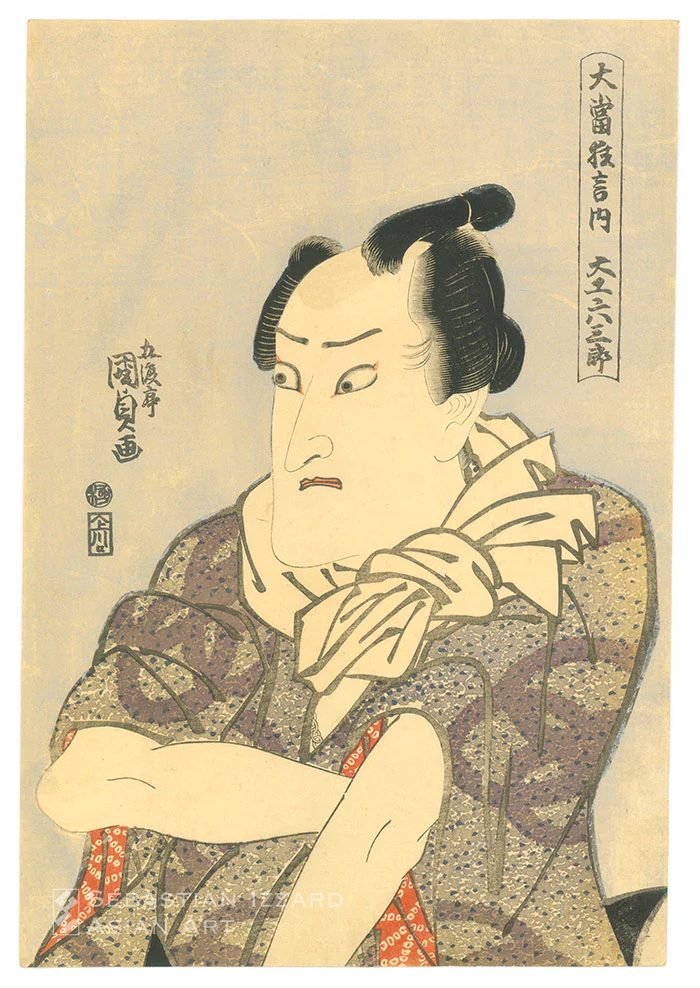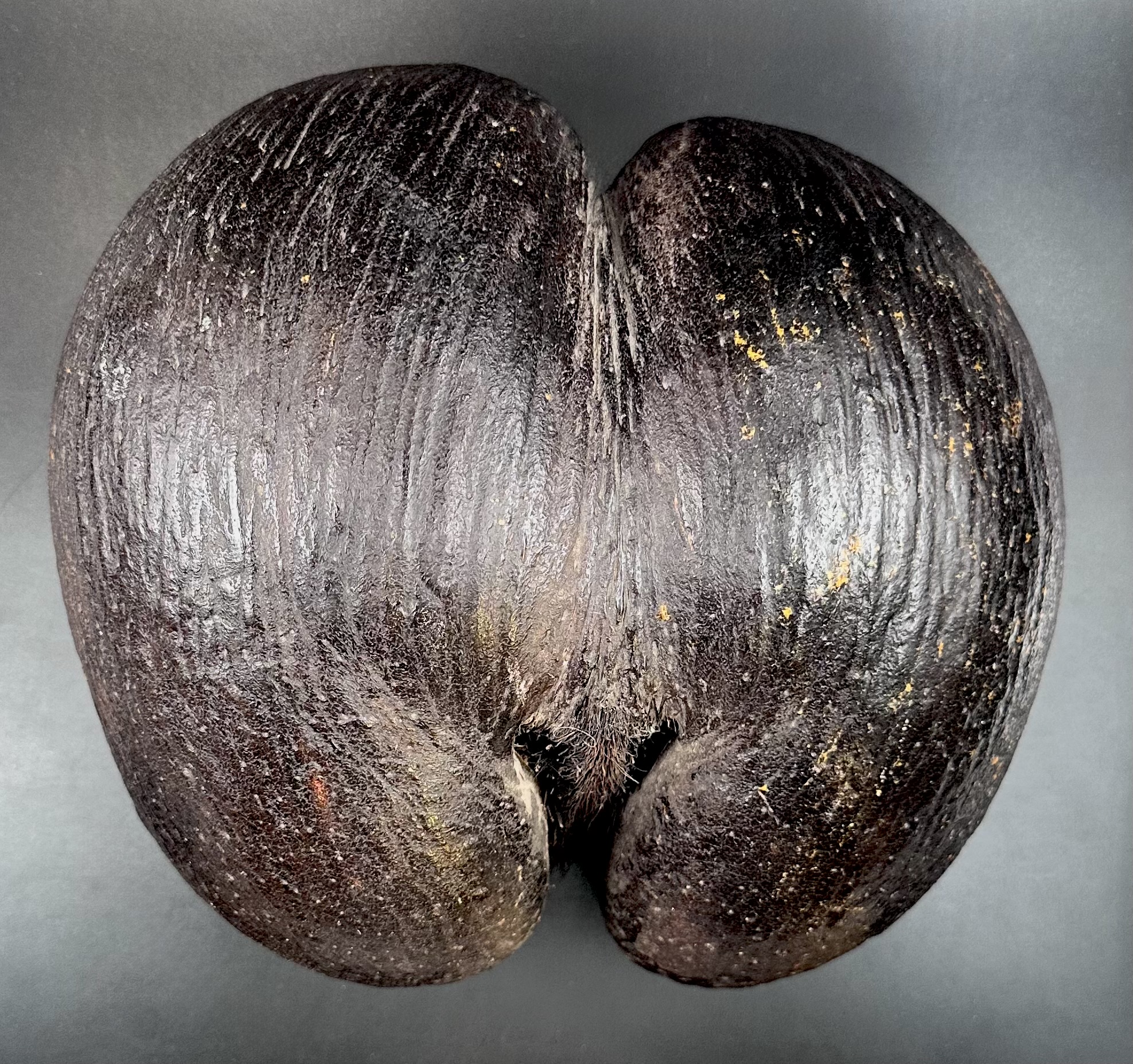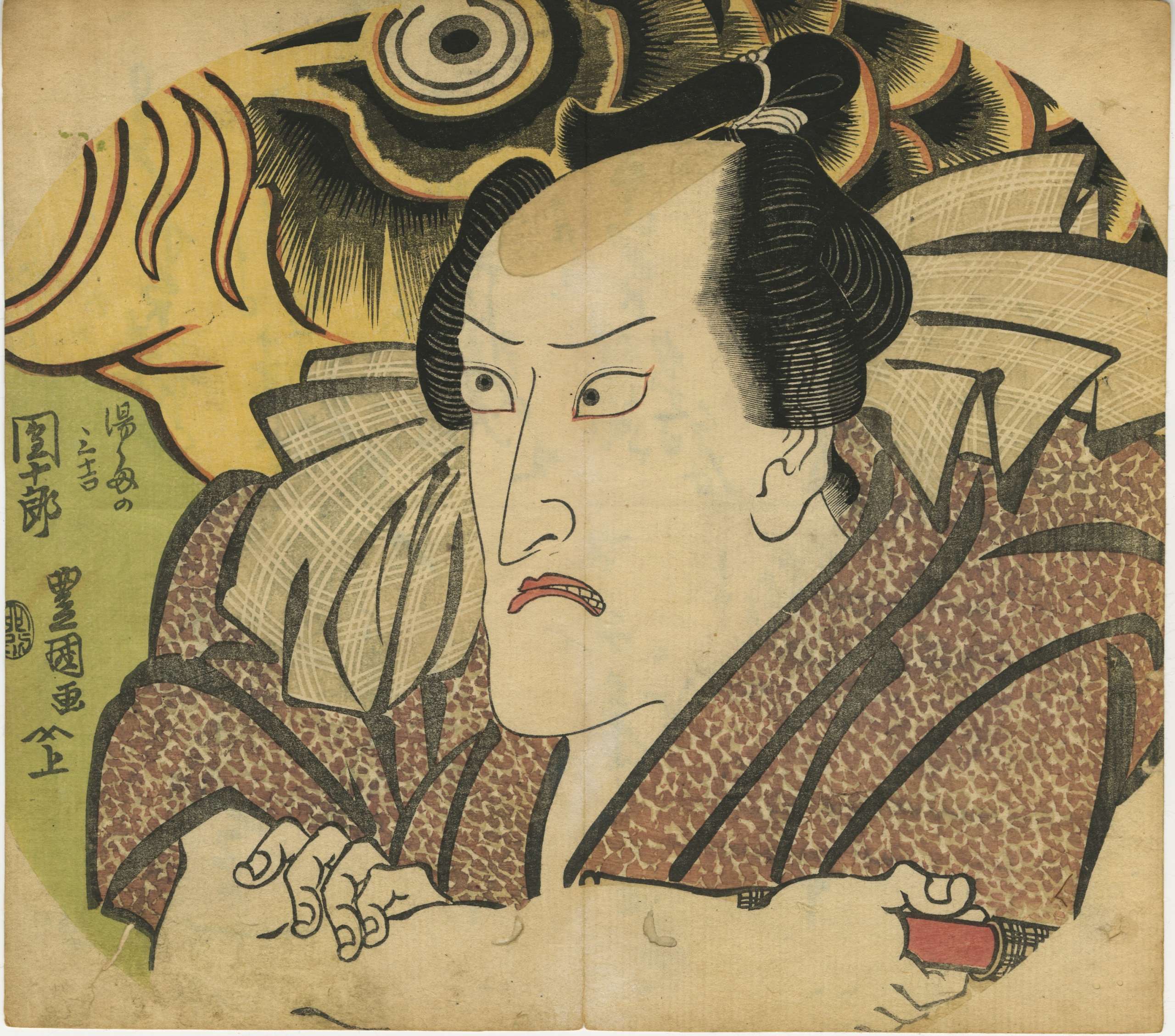 |
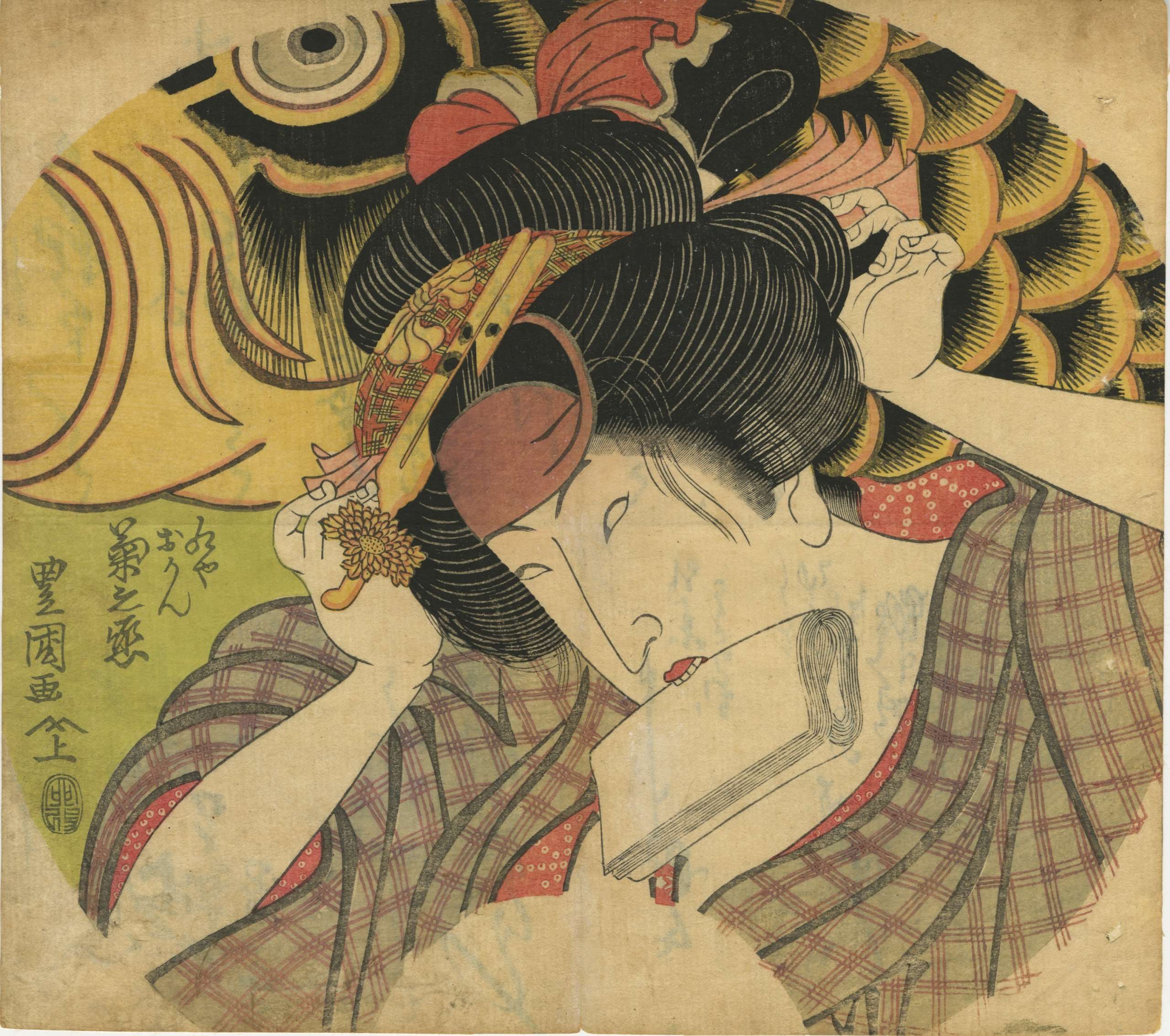 |
-
 NEWArtist: Utagawa Toyokuni I [初代豊国] (Japanese, 1769–1825) Signed: Toyokuni ga [豊国画]. Publisher: Iseya Sōemon [伊勢屋惣右衛門] (c. 1776 – November 1862); Marks 02-041 | 156a Date-Aratame Seal: 1819 (Bunsei 2, 文政二年) Media: Print (Yakusha-e, 役者絵); 221 × 253 mm Play: Ume Yanagi Wakaba no Kagazome (梅柳若葉加賀染) Theater: Tamagawa-za (玉川座), Edo, May 1819 Role: Kurenaiya Okan (紅屋おかん) Actor: Segawa Kikunojō V [瀬川菊之丞] (Japanese, 1802–1832); Other name: Segawa Tamon I (瀬川多聞初代) Bust-length, three-quarter-view portrait of Segawa Kikunojō V as Kurenaiya Okan in the play Ume Yanagi Wakaba no Kagazome, staged at Tamagawa-za in May 1819. The male actor Segawa Kikunojō V performs an onnagata role, portraying a courtesan. She is depicted adjusting her elaborate shimadamage-style coiffure, fixing a kanzashi (簪, hairpin) while holding onkotogami (御懲紙, tissue paper) in her mouth. The onkotogami was traditionally used for intimate hygiene, suggesting that the scene represents a moment after encountering a client. Her inner kimono is safflower-dyed and has a hemp leaf pattern (麻の葉, asa no ha). The top half of the background features a giant golden carp (鯉, koi), a recurring motif in this pair of prints often associated with strength, perseverance, and kabuki’s aragoto style. This print forms a pair with the portrait of Ichikawa Danjūrō VII as Yushima no Sankichi [SVJP-0439.2025], but no conclusive information is available regarding the relationship between their characters. The carp also alludes to Boys' Day (Tango no Sekku, 端午の節句), celebrated on May 5th each year.
NEWArtist: Utagawa Toyokuni I [初代豊国] (Japanese, 1769–1825) Signed: Toyokuni ga [豊国画]. Publisher: Iseya Sōemon [伊勢屋惣右衛門] (c. 1776 – November 1862); Marks 02-041 | 156a Date-Aratame Seal: 1819 (Bunsei 2, 文政二年) Media: Print (Yakusha-e, 役者絵); 221 × 253 mm Play: Ume Yanagi Wakaba no Kagazome (梅柳若葉加賀染) Theater: Tamagawa-za (玉川座), Edo, May 1819 Role: Kurenaiya Okan (紅屋おかん) Actor: Segawa Kikunojō V [瀬川菊之丞] (Japanese, 1802–1832); Other name: Segawa Tamon I (瀬川多聞初代) Bust-length, three-quarter-view portrait of Segawa Kikunojō V as Kurenaiya Okan in the play Ume Yanagi Wakaba no Kagazome, staged at Tamagawa-za in May 1819. The male actor Segawa Kikunojō V performs an onnagata role, portraying a courtesan. She is depicted adjusting her elaborate shimadamage-style coiffure, fixing a kanzashi (簪, hairpin) while holding onkotogami (御懲紙, tissue paper) in her mouth. The onkotogami was traditionally used for intimate hygiene, suggesting that the scene represents a moment after encountering a client. Her inner kimono is safflower-dyed and has a hemp leaf pattern (麻の葉, asa no ha). The top half of the background features a giant golden carp (鯉, koi), a recurring motif in this pair of prints often associated with strength, perseverance, and kabuki’s aragoto style. This print forms a pair with the portrait of Ichikawa Danjūrō VII as Yushima no Sankichi [SVJP-0439.2025], but no conclusive information is available regarding the relationship between their characters. The carp also alludes to Boys' Day (Tango no Sekku, 端午の節句), celebrated on May 5th each year. -
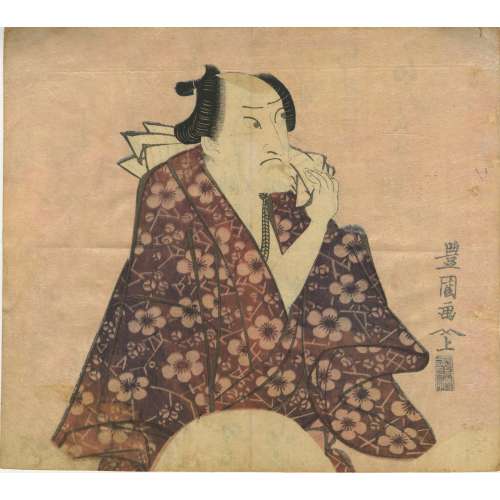 NEWArtist: Utagawa Toyokuni I [初代豊国] (Japanese, 1769–1825) Signed: Toyokuni ga [豊国画] Publisher: Iseya Sōemon [伊勢屋惣右衛門] (c. 1776 – November 1862); Marks 02-041 | 156a Gyōji Aratame Censor Seal: 行事改, 1810-18151 Media: Print (Uchiwa-e, うちわ絵, fan print), kira-zuri (きら摺り, mica printing); 222 × 250 mm
NEWArtist: Utagawa Toyokuni I [初代豊国] (Japanese, 1769–1825) Signed: Toyokuni ga [豊国画] Publisher: Iseya Sōemon [伊勢屋惣右衛門] (c. 1776 – November 1862); Marks 02-041 | 156a Gyōji Aratame Censor Seal: 行事改, 1810-18151 Media: Print (Uchiwa-e, うちわ絵, fan print), kira-zuri (きら摺り, mica printing); 222 × 250 mmActor: Onoe Baikō III [三代目尾上梅幸] (Japanese, 1784–1849); Other names: Onoe Kikugorō III (尾上菊五郎), Ōkawa Hashizō I (大川橋蔵初代), Onoe Matsusuke II (二代目尾上松助), Onoe Eizaburō I (初代尾上栄三郎)
Role: Konjin Chōgorō (金神長五郎) Play: Ku Kyōdai Shōbu Katabira (句兄弟菖蒲帷子) Theater: Nakamura-za (中村座), Edo, 1815 Half-length, three-quarter-view, facing to the left portrait of Onoe Baikō III as Konjin Chōgorō, in the play Ku Kyōdai Shōbu Katabira, staged at Nakamura-za in 1815. The actor wears a purple kimono with a plum blossom motif (梅, ume).A print from the Waseda University Tsubouchi Memorial Theatre Museum also depicts Onoe Baikō III as Konjin Chōgorō, showing him holding a box inscribed with 神金 (Kane no Kami). The name Konjin consists of the same kanji reading right to left (金神).
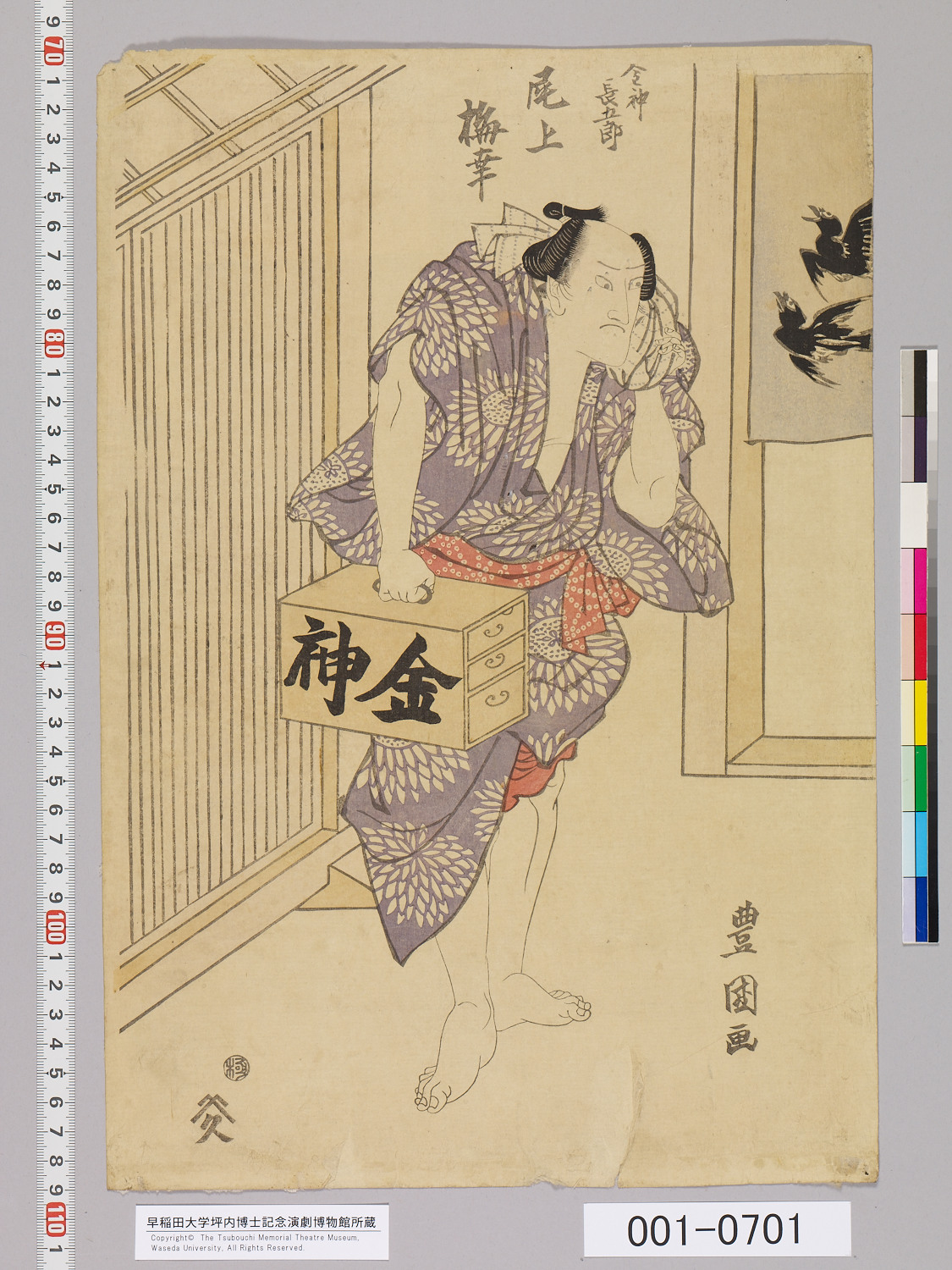
Konjin Chōgorō is a legendary figure in Japanese folklore, renowned as a formidable sumo wrestler. His tales often depict him engaging in supernatural feats, such as vanquishing demons and showcasing extraordinary strength.
In the realm of kabuki theatre, Konjin Chōgorō's character has been portrayed in various plays, though specific details about Ku Kyōdai Shōbu Katabira (句兄弟菖蒲帷子) remain unknown.
Notes
-
A certain confusion regarding the attribution of this print arises from the statement by Andreas Marks (Publishers, 2011, p. 488), which asserts that the gyōji aratame seal was used exclusively for fan prints between 1810 and 1814. However, it is known that Onoe Baikō III performed the role of Konjin Chōgorō at Nakamura-za in the 5th month of 1815. Marks also notes that the earliest known fan print bearing this seal dates to 1810; based on this new evidence, we may now consider the latest known instance to be the 5th month of 1815.
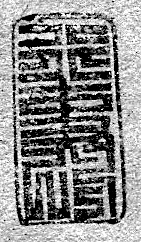
-
-
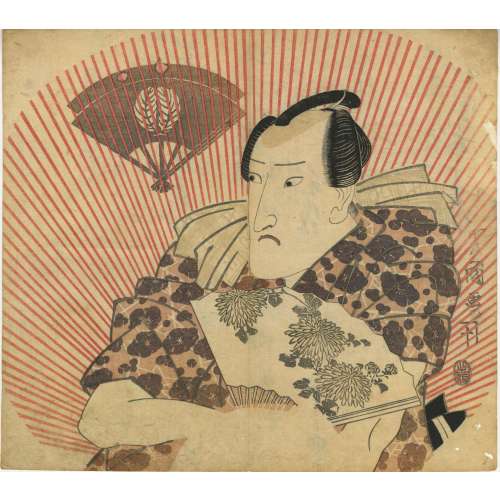 NEW
NEWArtist: Utagawa Toyokuni I [初代豊国] (Japanese, 1769–1825)
Signed: Toyokuni ga [豊国画]
Publisher: Kojimaya Jūbei [小嶋屋重兵衛] (Japanese, c. 1797–1869); seal [十]; Marks 06-014 | 264a
Date-Aratame Seal: 1822 (Bunsei 5, 文政五年)
Media: Print (Uchiwa-e, うちわ絵, fan print); 223 × 250 mm
Actor: Onoe Kikugorō III [三代目 尾上菊五郎] (Japanese, 1784–1849); other names: Onoe Baikō III (尾上梅幸), Ōkawa Hashizō I (大川橋蔵初代), Onoe Matsusuke II (二代目尾上松助), Onoe Eizaburō I (初代尾上栄三郎)
Half-length, three-quarter-view portrait of Onoe Kikugorō III, depicted without stage makeup. The actor wears a kimono patterned with plum blossoms (梅, ume), symbolising perseverance and longevity. A neck scarf with a 格子 (kōshi) pattern is visible, and he holds a folding fan (扇, ōgi) decorated with chrysanthemums (菊, kiku).
Above his head is the Onoe family crest (mon), embracing oak leaves on layered fans. This emblem, known as the crest of the Otowaya line, commemorates a shogunal gift of rice cakes wrapped in oak leaves, placed on a fan, and presented to Onoe Kikugorō I.
The background features a radiating red-line pattern, possibly representing the bamboo structure of an uchiwa fan. The absence of kumadori (歌舞伎隈取, kabuki makeup) suggests that the actor is not portrayed in a specific role.
In 1822, Onoe Kikugorō III performed at Kawarazaki-za before month 11 and at Ichimura-za and Nakamura-za afterwards.
The print has been backed for preservation with a sheet of paper featuring calligraphy, likely contemporary to the print itself. The backing paper appears to have been repurposed, a common historical practice in the Edo period, where discarded documents or manuscripts were reused to reinforce delicate prints.
Kunisada portrayed the same actor in 1815 as Rokusaburō, the Carpenter (Daiku Rokusaburō).
-
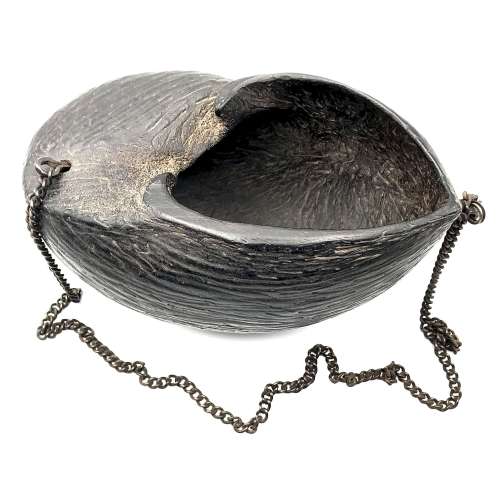 NEW
NEWMaterial: Coco de Mer (Lodoicea maldivica) shell with metal chain
Origin: Likely Persia (Iran) or the Indian subcontinent
Date: 19th century
Dimensions: 205 × 135 × 100 mm
Weight: 324 gThis begging bowl (kashkul) is crafted from the shell of a Coco de Mer (Lodoicea maldivica) seed, a rare and symbolic material historically associated with mysticism and exotic origins. The natural curvature of the shell has been hollowed and smoothed for functional use, preserving its organic ridged texture on the exterior. Metal rings are affixed at both ends, supporting a linked chain handle, allowing the bowl to be carried or hung.
The kashkul was traditionally used by Sufi dervishes as a symbol of humility and asceticism, carried as a vessel for alms and spiritual offerings. The use of Coco de Mer for such objects was particularly esteemed due to its rarity, as the seed was believed to possess mystical properties and was highly valued in Indian Ocean trade networks.
- Exotic and Sacred Material—Coco de Mer was once considered a fruit from an underwater tree, enhancing its mystical reputation.
- Mystical Associations – In Sufi thought the empty bowl symbolizes detachment from material life and openness to divine sustenance.
- Trade and Status – Such bowls were often prized possessions of high-ranking Sufi masters, symbolizing spiritual authority and renunciation of worldly wealth.
While many kashkuls were crafted from metal (bronze, brass, or silver) and intricately decorated with Persian calligraphy and floral motifs, those made from Coco de Mer were rarer and more valued. The organic curves of the seed naturally complemented the aesthetic and spiritual function of the vessel, making it a highly desirable object.
This piece represents a rare intersection of natural rarity, spiritual tradition, and craftsmanship, making it a notable example of historical Sufi material culture.
See Coco de Mer Seed (Lodoicea maldivica) [VO-0474.2024] in this collection.
-
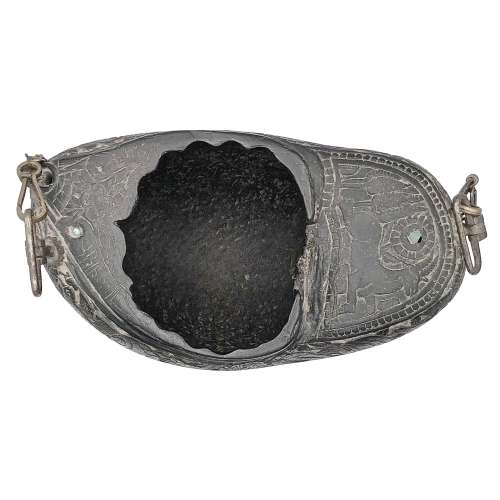 NEW
NEWMaterial: Coco de Mer (Lodoicea maldivica) shell with engraved decoration, bronze chain, metal fittings, and inlaid elements
Origin: Likely Persia (Iran)
Date: 19th century
Dimensions: 270 × 150 × 130 mm
Weight: 608 gThis begging bowl (kashkul) is carved from the shell of a Coco de Mer (Lodoicea maldivica) seed, a material historically associated with mysticism and spiritual significance in Persian Sufi traditions. The exterior is intricately engraved with floral motifs, architectural elements, and figural depictions, while a bronze chain is attached via metal loops for carrying or suspension. The bowl retains its natural curvature with a scalloped rim and detailed craftsmanship.
- Floral and Botanical Motifs: Engraved sunflowers, vines, and foliage patterns symbolizing divine wisdom and enlightenment.
- Figural Depiction: One side features a standing figure in military attire, possibly a Persian warrior, historical figure, or Sufi dervish.
- Architectural Details: Arches and ornamental borders suggest Persian or Mughal artistic influences.
- Inlaid Accents: Small inlays of turquoise or glass enhance the visual appeal and craftsmanship.
The kashkul was traditionally used by Sufi dervishes as a symbol of renunciation and humility, carried to receive alms and spiritual offerings. The use of Coco de Mer, a rare and exotic material, elevated the object's status, making it a prized possession among high-ranking Sufi mystics.
Unlike plain metal kashkuls, which often bore inscriptions of Persian poetry or Quranic verses, this example features extensive figural and architectural designs, suggesting it may have been a presentation or ceremonial piece rather than a simple, functional object. The presence of a bronze chain reinforces its portability and use in daily Sufi practices.
This piece is a rare blend of natural form and intricate artistic craftsmanship, making it a significant example of Persian Sufi material culture.
See Coco de Mer Seed (Lodoicea maldivica) [VO-0474.2024] in this collection.
-
 NEWArtist: Utagawa Kuniyoshi (歌川国芳) (1797–1861) Signed: 一勇斎 (Ichiyūsai) in a yellow cartouche, 國芳画 (Kuniyoshi ga) in a red cartouche Publisher: 未詳 (Yama-Ta), seal [板元, 太] – Hanmoto, Ta; Marks 19-044 | U421b Censor Seal: Aratame + Ansei 3 (3rd lunar month, 1856) Block Carver: 彫竹 (Hori Take), identified as Yokokawa Takejirō (横川竹二郎) (fl. 1845–1863) Media: Rigid fan print (Aiban Yoko-e Uchiwa-e, 合判横絵 団扇絵), 227 × 286 mm Half-length portrait of a high-ranking courtesan (oiran, 花魁) seated in a three-quarter view, holding a porcelain sake cup decorated with a blue mon of stylized oak leaves (kashiwa, 柏). She gazes downward at a partially unrolled letter resting on her lap. Her elaborate hairstyle, adorned with multiple kogai (ornamental hairpins) featuring golden floral motifs, signifies her elevated status within her profession. Her layered kimono displays a combination of red, blue, and black geometric patterns, emphasizing the luxurious textiles associated with courtesans of her rank. The stylized oak leaves on the sake cup may allude to the family mon of Onoe family of kabuki actors, evoking the overlap between theatre and the pleasure quarters. The background portrays a night scene in the Yoshiwara Pleasure District (吉原), where figures move beneath lantern-lit buildings, showing the vibrant nightlife of Edo.
NEWArtist: Utagawa Kuniyoshi (歌川国芳) (1797–1861) Signed: 一勇斎 (Ichiyūsai) in a yellow cartouche, 國芳画 (Kuniyoshi ga) in a red cartouche Publisher: 未詳 (Yama-Ta), seal [板元, 太] – Hanmoto, Ta; Marks 19-044 | U421b Censor Seal: Aratame + Ansei 3 (3rd lunar month, 1856) Block Carver: 彫竹 (Hori Take), identified as Yokokawa Takejirō (横川竹二郎) (fl. 1845–1863) Media: Rigid fan print (Aiban Yoko-e Uchiwa-e, 合判横絵 団扇絵), 227 × 286 mm Half-length portrait of a high-ranking courtesan (oiran, 花魁) seated in a three-quarter view, holding a porcelain sake cup decorated with a blue mon of stylized oak leaves (kashiwa, 柏). She gazes downward at a partially unrolled letter resting on her lap. Her elaborate hairstyle, adorned with multiple kogai (ornamental hairpins) featuring golden floral motifs, signifies her elevated status within her profession. Her layered kimono displays a combination of red, blue, and black geometric patterns, emphasizing the luxurious textiles associated with courtesans of her rank. The stylized oak leaves on the sake cup may allude to the family mon of Onoe family of kabuki actors, evoking the overlap between theatre and the pleasure quarters. The background portrays a night scene in the Yoshiwara Pleasure District (吉原), where figures move beneath lantern-lit buildings, showing the vibrant nightlife of Edo. -
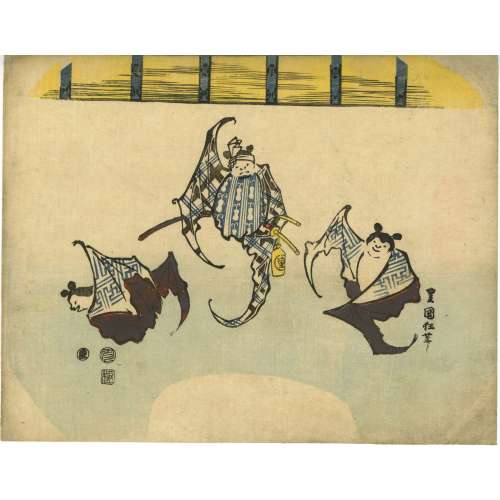 NEWArtist: Utagawa Toyokuni II [歌川豊国二代] a.k.a. Toyoshige [豊重] (Japanese, (1777 – 1835) Signed: 豊国狂筆 (Toyokuni kyō-hitsu, "mad brush of Toyokuni") Publisher: Maru-Jū (丸重), seal Jū (重), Marks reference 08-079 | U190a (1826–1829, only on fan prints) Censor Seal: Kiwame + Bunsei 12 (Year of the Ox [丑], 1829) Media: Uchiwa-e (fan print), color woodblock print, 230 × 293 mm
NEWArtist: Utagawa Toyokuni II [歌川豊国二代] a.k.a. Toyoshige [豊重] (Japanese, (1777 – 1835) Signed: 豊国狂筆 (Toyokuni kyō-hitsu, "mad brush of Toyokuni") Publisher: Maru-Jū (丸重), seal Jū (重), Marks reference 08-079 | U190a (1826–1829, only on fan prints) Censor Seal: Kiwame + Bunsei 12 (Year of the Ox [丑], 1829) Media: Uchiwa-e (fan print), color woodblock print, 230 × 293 mmA fantastical kabuki-themed scene depicting three anthropomorphic bats, dressed in Edo-period costumes. The central figure, likely Ichikawa Danjūrō VII (市川團十郎七, 1791–1859), is distinguished by his costume featuring a gourd motif (瓢箪, hyōtan)—a symbol closely linked to the Ichikawa family. He wears two swords, further identifying him as a kabuki hero, and carries a sake flask marked with what appears to be the publisher's emblem. His raised arm (or wing?) suggests a dramatic action, possibly striking or threatening the bat figure on the left, who recoils in response.
The two side bats, also dressed in patterned kimono, display expressions contrasting with the central figure—one appearing startled, while the other remains cheerful. The oxidized lead-orange pigment used in the lower portions of their wings suggests depth and texture.
This print reflects Danjūrō VII’s association with both the bat (蝙蝠, kōmori) and the double gourd. Bats were considered lucky symbols due to their resemblance to the character of "good fortune" (福, fuku), and Danjūrō VII often incorporated bat motifs into his stage costumes. The Ichikawa family's crest, the mimasu (三升, "three squares"), was more commonly used, but the double gourd and bat imagery appeared in promotional materials, reinforcing his theatrical identity. -
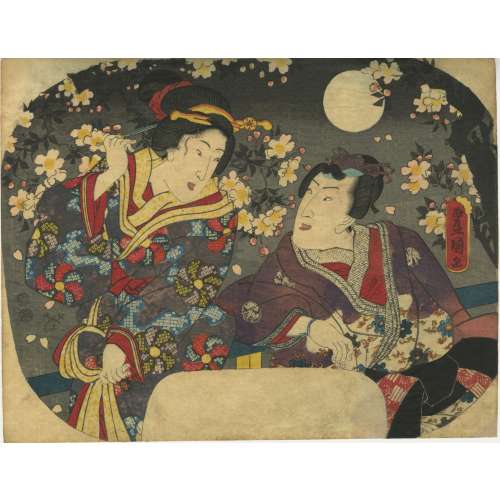 NEWArtist: Utagawa Kunisada (Toyokuni III) (歌川国貞) (1786–1865) Signed: 豊国画 (Toyokuni ga) in a red toshidama cartouche Publisher: Iseya Sōemon (伊勢屋惣右衛門), Marks reference 19-047 | 156d, seal Hanmoto, Ue (板元, 上) Censor Seal: Double nanushi (Watanabe & Kunigasa) Date: Kaei 2-3 (1849–1850), based on censor seals. Media: Uchiwa-e (fan print), color woodblock print, 230 × 297 mm
NEWArtist: Utagawa Kunisada (Toyokuni III) (歌川国貞) (1786–1865) Signed: 豊国画 (Toyokuni ga) in a red toshidama cartouche Publisher: Iseya Sōemon (伊勢屋惣右衛門), Marks reference 19-047 | 156d, seal Hanmoto, Ue (板元, 上) Censor Seal: Double nanushi (Watanabe & Kunigasa) Date: Kaei 2-3 (1849–1850), based on censor seals. Media: Uchiwa-e (fan print), color woodblock print, 230 × 297 mmAn elegant moonlit conversation unfolds between a man and woman beneath blossoming cherry branches. The full moon and falling petals create a romantic yet fleeting atmosphere, reminiscent of courtly themes in The Tale of Genji (源氏物語).
The woman on the left wears a multi-layered kimono featuring pinwheel floral motifs and geometric patterns in red, blue, and gold. She lifts a hairpin (kanzashi, 簪) to adjust her hair, suggesting modesty, refinement, or quiet engagement in conversation.
The man on the right wears a dark purple haori (羽織, outer robe) adorned with gentian (rindō, 竜胆) mon, a crest associated with nobility and refinement. His red and white obi features Genji-mon, further reinforcing the aesthetic and symbolic ties to Genji Monogatari.
The gentian mon and purple hues evoke Heian-era literary aesthetics, aligning with Genji Monogatari's visual traditions. Though the characters in this fan print are not explicitly named, the composition closely resembles the scene "At moon-viewing night, Genji visits Yūgao," presented below.
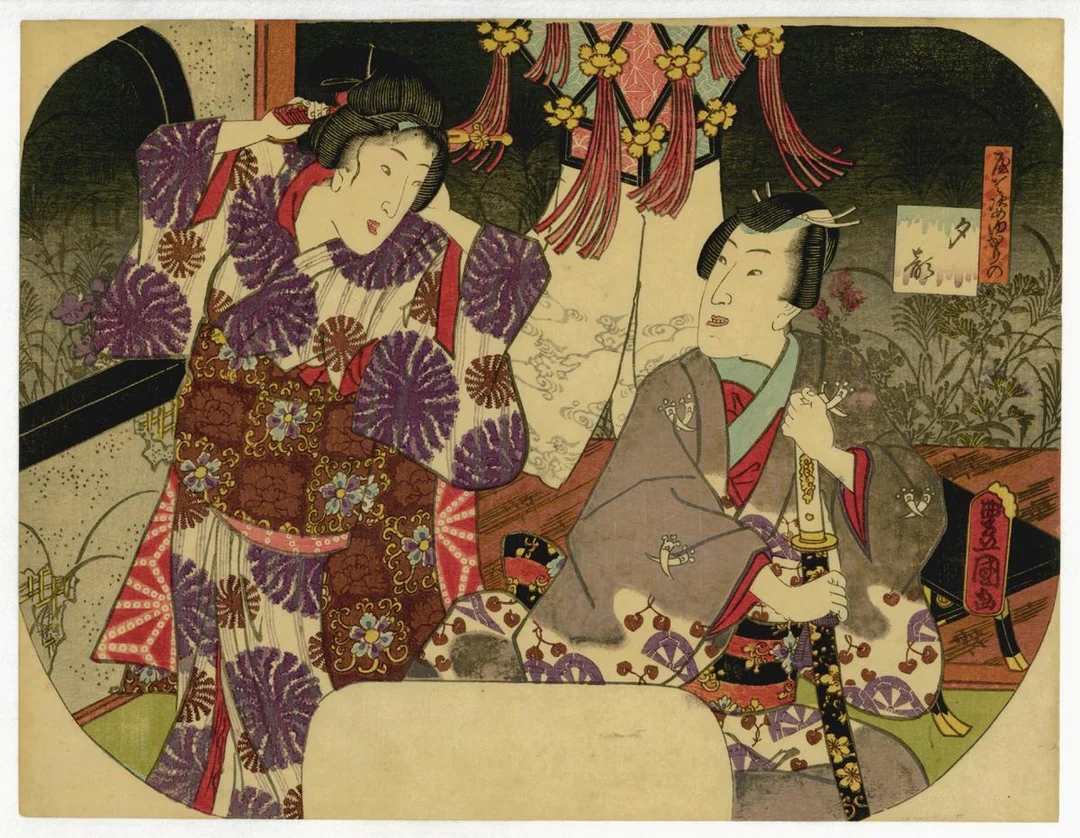
-
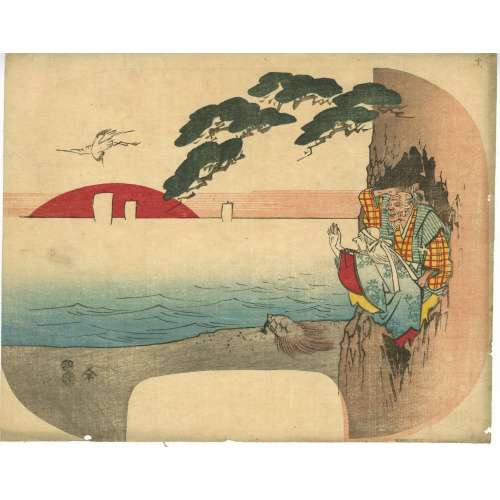 NEWArtist: Attributed to Katsushika Hokusai (葛飾 北斎) (1760–1849) – unsigned. Publisher: Unknown, seal Hei (平); Marks 05-004 | U377a (1848) Censor Seal: Double nanushi Hama (濱) & Kunigasa (衣笠) Date: Kōka 4–5 / Kaei 1 (1847–1848) Media: Rigid fan print (Aiban Yoko-e Uchiwa-e, 合判横絵 団扇絵), 239 × 301 mm The legendary elderly couple Jō and Uba (尉と姥), spirits of the paired pines of Takasago (高砂) and Sumiyoshi (住吉), are known as the Aioi-no-Matsu (相生の松). They symbolize marital harmony, longevity, and the enduring bond of love. The Takasago legend is one of the oldest in Japanese mythology, famously portrayed in the Noh play Takasago no Uta (高砂の歌).
NEWArtist: Attributed to Katsushika Hokusai (葛飾 北斎) (1760–1849) – unsigned. Publisher: Unknown, seal Hei (平); Marks 05-004 | U377a (1848) Censor Seal: Double nanushi Hama (濱) & Kunigasa (衣笠) Date: Kōka 4–5 / Kaei 1 (1847–1848) Media: Rigid fan print (Aiban Yoko-e Uchiwa-e, 合判横絵 団扇絵), 239 × 301 mm The legendary elderly couple Jō and Uba (尉と姥), spirits of the paired pines of Takasago (高砂) and Sumiyoshi (住吉), are known as the Aioi-no-Matsu (相生の松). They symbolize marital harmony, longevity, and the enduring bond of love. The Takasago legend is one of the oldest in Japanese mythology, famously portrayed in the Noh play Takasago no Uta (高砂の歌).Aioi-no-Matsu – The Paired Pines of Takasago and Sumiyoshi
The Aioi-no-Matsu refers to two pine trees growing separately but intertwined at the roots, representing an unbreakable union.- The Takasago pine (高砂の松) grows in Harima Province, while the Sumiyoshi pine (住吉の松) stands in Settsu Province.
- Though physically distant, these trees are spiritually connected, like Jō and Uba, the aged couple who embody their spirits.
- The phrase "The wind that blows through Takasago reaches Sumiyoshi" symbolizes the continuity of love and harmony across time and space.
Aioi-no-Matsu in the Noh Play Takasago
The Noh play Takasago, attributed to Zeami, popularized this imagery.- Jō and Uba appear as an elderly couple raking pine needles, revealing themselves as the spirits of the Aioi-no-Matsu.
- The play conveys the theme of eternal harmony between husband and wife, making Aioi-no-Matsu a symbol of auspicious blessings for weddings and longevity celebrations.
Symbolism in the Print
This print incorporates traditional symbols of longevity and prosperity:- A minogame (蓑亀, "straw-cloaked turtle"), representing immortality, rests near the shore.
- A crane (鶴, tsuru), a symbol of marital fidelity.
- The rising sun over the ocean represents renewal and hope for the coming year.
- Jō and Uba’s presence under the Aioi-no-Matsu (Paired Pines) evokes the traditional New Year’s wish for long life and unity.
- The minogame and crane further reinforce New Year’s themes of prosperity and fortune.
Comparison to MFA Boston Prints
This print shares strong visual and thematic connections with two works attributed to Hokusai in the MFA Boston collection:- Accession No. 21.10269 – "Jō and Uba, the Spirits of the Pine Trees of Takasago and Sumiyoshi"
- Depicts the couple sweeping pine needles, reinforcing themes of domestic harmony and renewal.
- Includes a minogame and a flying crane, similar to this print.
- Accession No. 21.7869 – Another version of "Jō and Uba"
- Shows Jō and Uba standing, gazing at the sea, in a more expansive composition.
- Features a large pine tree, crashing waves, and a red sun, mirroring the background elements in this print.
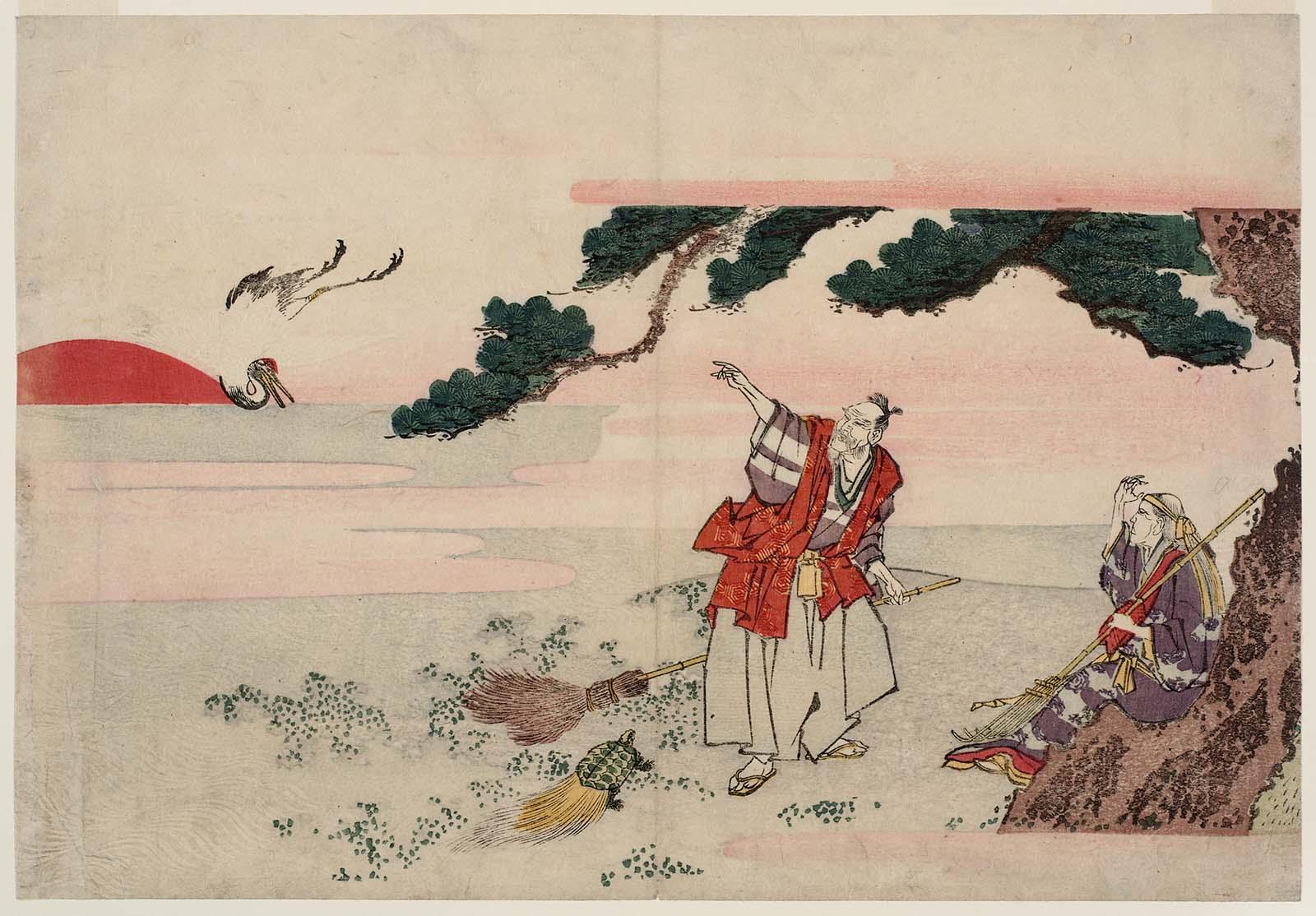
MFA-B № 21.10269
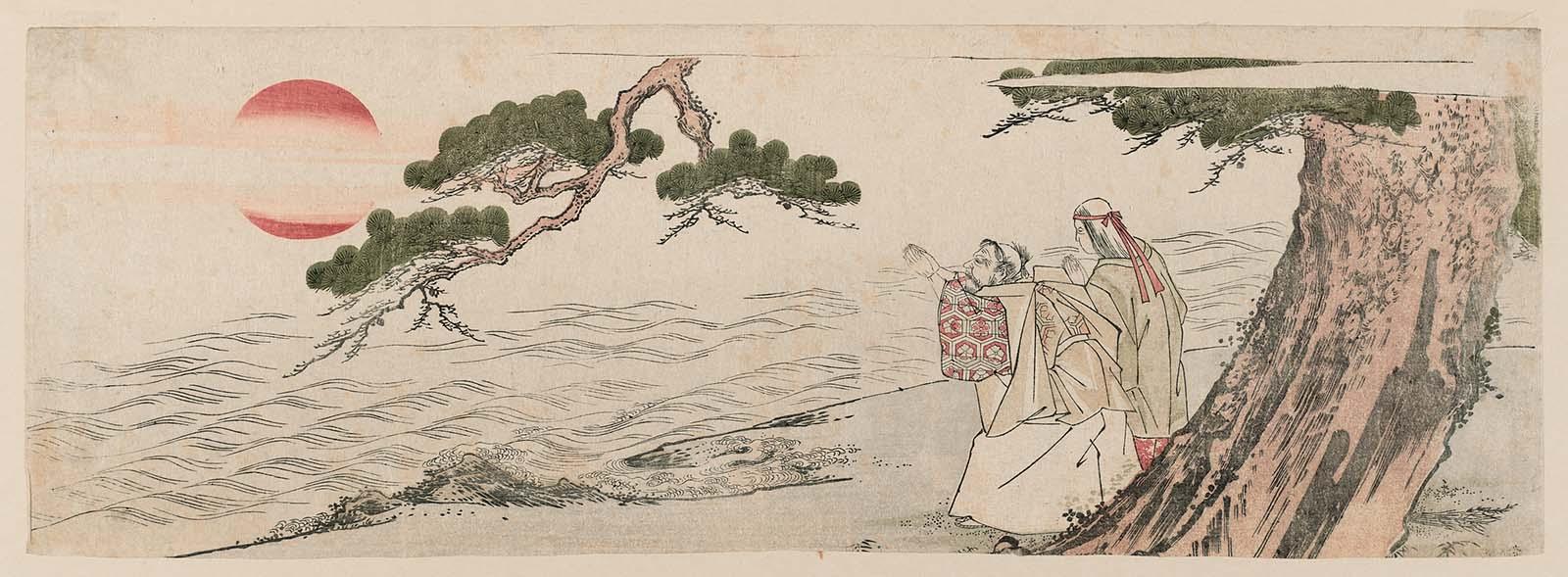
MFA-B № 21.7869
-
 NEWArtist: Utagawa Kuniyoshi (歌川国芳) (1797–1861) Signed: Ichiyūsai Kuniyoshi ga [一勇斎 國芳画] in red cartouche Date: VI/1842 – V ic/1846, single nanushi censor seal Murata (村) for censor Murata Sahei [村田佐兵衛]. Publisher: Unknown, Izuzen (Bei, 米); Marks 06-028 | U103a Media: Rigid fan print (Aiban Yoko-e Uchiwa-e, 合判横絵 団扇絵), 224 x 290 mm
NEWArtist: Utagawa Kuniyoshi (歌川国芳) (1797–1861) Signed: Ichiyūsai Kuniyoshi ga [一勇斎 國芳画] in red cartouche Date: VI/1842 – V ic/1846, single nanushi censor seal Murata (村) for censor Murata Sahei [村田佐兵衛]. Publisher: Unknown, Izuzen (Bei, 米); Marks 06-028 | U103a Media: Rigid fan print (Aiban Yoko-e Uchiwa-e, 合判横絵 団扇絵), 224 x 290 mmHalf-length portrait of a woman facing slightly to the right. She wears a patterned kimono with multiple floral and seasonal motifs, including uchiwa (round fans), plum blossoms, maple leaves, chrysanthemums, snow-covered bamboo, pine branches, and peonies. Her obi is tied in front, and a red collar is visible beneath the layers. Her hair is arranged in an elaborate updo and is adorned with a hairpin featuring a rabbit and a crescent moon, referencing lunar symbolism. She dedicates a hand towel at a washing trough (手水舎, temizuya) in a shrine. Inscriptions on the towels.
In the background, several towels are hanging, featuring various mon (family crests) and symbols:
- Three oak leaves
- Crossed or intersecting hawk feathers
- Kiri-mon (Paulownia crest, associated with Kuniyoshi)
- Toshidama (seal of the Utagawa school)
- Masu (枡, measuring box) motif – a square with diagonal lines
- Kuniyoshi Project
- [LIB-3428.2025] Christie’s, New York: Japanese Prints, Paintings, and Screens, Monday, 24 November 1997 / Sales Catalogue, № 130, p. 63.



